How to Travel to San Francisco Every Other Month for Five Years
January 25, 2018 📬 Get My Weekly Newsletter ☞
I’ve been traveling to San Francisco every two months (more or less) for the last five years as part of my job. The hardest part used to be the traveling and staying in hotels (now it’s that I pack so much activity into such a small amount of time, I barely see any of my San Francisco friends any more). This is about how to make the travel and hotels suck less, and if you are currently working remotely, or planning to, reducing travel anxiety and hassle should be something you actively address.
Seeing your co-workers, boss, users, or business partners in person is critical to making remote work effective, especially if they are not accustomed to part of their team being in another location. This means travel, and the more you can do it, the better. Assuming your company is covering the expenses, your focus should be to reduce the anxiety and hassle, aim for a predictable experience, and make sure you show up ready to work and be your best.
The key to this is to plan ahead and be organized. When you are organized in how you pack, what you bring, and how you get around, the travelling part just happens, and when you get to where you are staying, you don’t have to rush around finding things you forgot.
Before Your First Trip
Before you travel anywhere, you need luggage. You need one suitcase that fits in an overhead bin and one backpack that fits under the seat in front of you.
Suitcase
You should avoid checking bags, so a rollerbag that fits in an overhead bin is what you want. It’ll hold a week’s worth of clothes easily. I recommend a “spinner”-style that allows you to move the bag around on four wheels in an upright position. Invest in something high quality, especially if you are going to be travelling more than a couple times a year.
The Wirecutter recommends the Briggs & Riley Baseline, which is pricey but worth it. The Wirecutter has cheaper options from other brands that they recommend, but remember that your suitcase should serve you for many years.
The “spinner” feature is critical, because it makes maneuvering in airports, hotels, streets, and offices a lot easier. For years, my wife had a non-spinner bag that you have to drag behind you, and it was a constant source of frustration when we traveled, especially if we needed to pick up the pace and weave through a congested area quickly.
You will also need a carry-on bag that can fit under the seat in front of you.
Carry On
Your carry-on bag should be able to hold your laptop and other electronic needs you will have during travel. For me, function and organizing is more important than fashion. I highly recommend the Tom Bihn Synapse 25. As we’ll see below, it holds an amazing amount of stuff and has great organizing features to make travel, packing, and getting around easy.
Whatever you get, I recommend a backpack over a messenger or tote bag. I used to swear by messenger bags, but a couple weeks in Argentina killed my shoulder. Your carry-on bag will often have to hold a lot of stuff, especially going to/from the airport, and having all that weight on one shoulder can cause stress and pain. A backpack is more ergonomic.
The Synapse includes additional straps to distribute the weight evenly throughout your upper-body, making it comfortable to carry a very full pack. This also means you can connect it to your body snugly if you need to e.g. run between stops. A messenger bag tends to flop around and jostle more as you move.
Lastly, you need to invest in a few accessories, depending on your particular needs.
Accessories
There are many travel accessories you can get, and I can’t recommend anything specific, because these things tend to solve problems that drive your individual anxiety or frustration (for example, I can’t sleep on a plane, so I will never buy a travel pillow). I’ll share a few of my critical accessories so you know what I mean, but think about what will cause you the most stress or can address your specific comfort needs.
Having to depend on flight crews to stay hydrated isn’t ideal, especially when your options are sugary sodas or a tiny bottle of room temperature water. I’m at peace when I’ve got some cold iced tea readily available, so I carry an empty Hyrdro Flask 32 ounce wide mouth vaccuum sealed bottle with me, and fill it up with iced tea after clearing security:
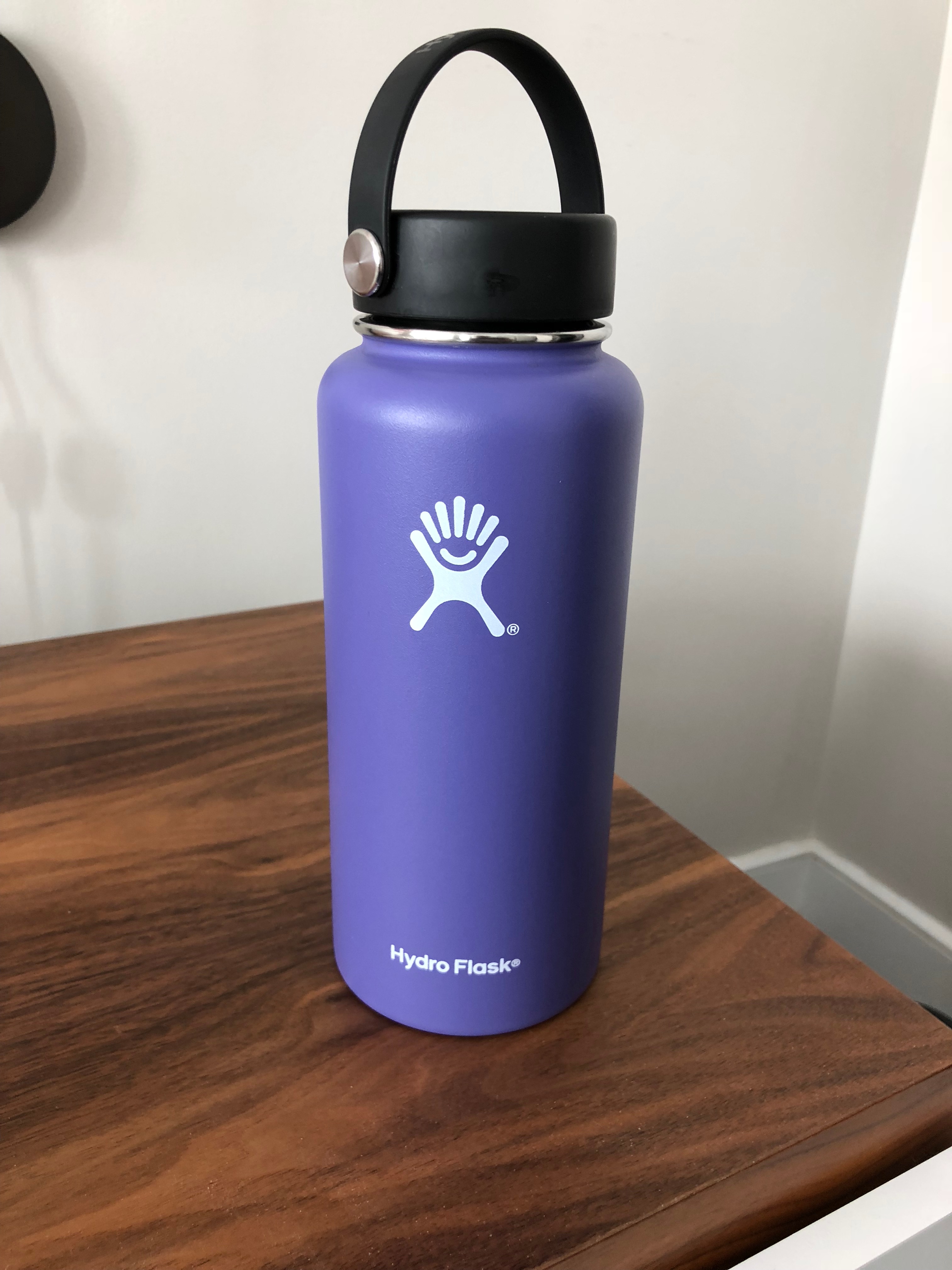
This holds an entire Trenta Iced Tea from Starbucks, and the widemouth makes it easy to fill up. It keeps the tea very cold during the entire cross-country flight and cab to the hotel (6+ hours!). Likely has the same effect for warm beverages.
Traveling also involves a lot of waiting in cramped, dirty, spaces (especially if you are in downtown San Francisco and can’t check into your hotel). I carry a purse hook (available at your nearest Container Store or likely online) that allows me to hang my backpack pretty much anywhere, keeping it off the floor and nearby:
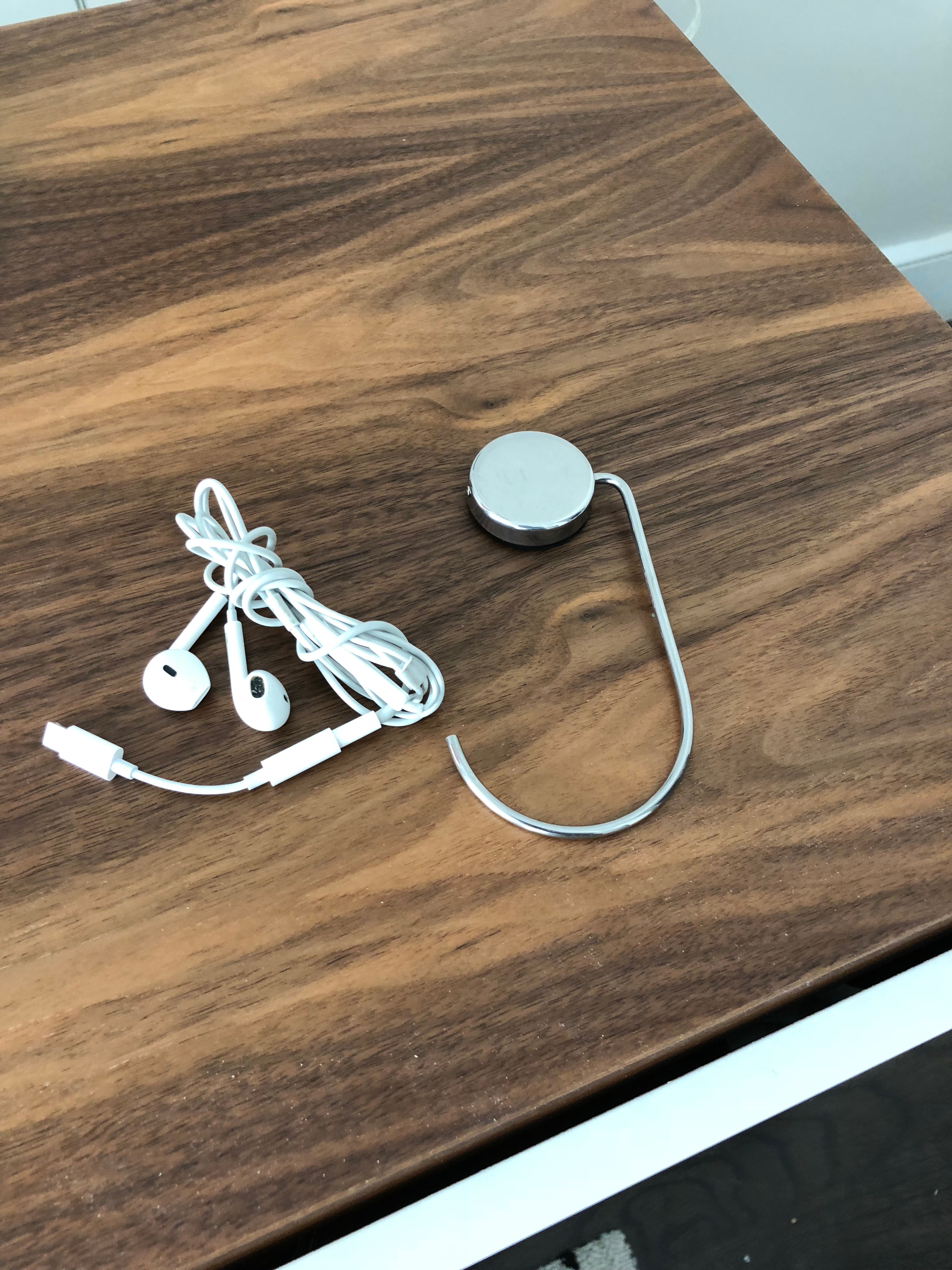
The third and final critical travel accessory is also pictured above, which is a set of Apple Earbuds with that silly Lightning adapter. I get bored easily and being able to plug into a device to listen to music or watch a movie is a great way to pass the time, but you don’t necessarily know what you’ll be plugging into or if your Bluetooth headphones are charged and working.
The key is to figure out what is going to put you at ease or alleviate your anxiety and feel OK spending some money to make it go away or reduce risk.
Next up is packing, and we’ll see a lot more of my travel accessories there.
Packing
With two pieces of luggage, the best strategy is to put all critical items into your carry-on. I like to think about what might happen if my suitcase doesn’t make it to the hotel: what would I need to get through a day? For me, this is all my electronics (laptop, iPad, Kindle), requisite chargers, headphones, battery pack, and a change of underwear.
You don’t know what’s going to happen to your main piece of luggage. You may be required to check it, and it may get lost, and you might not have access to it for quite sometime. You also may need to leave it at a hotel out of your control, so having all of your important and critical possessions in your backpack means you’re good to go with whatever situation arises.
As for packing the bags themselves, packing cubes are critical to staying organized. I use them religiously, as you will see, and they serve a few purposes. First, they allow you to open your bag in a cramped or unsafe location without the risk of things falling out. If you need to quickly dig into your suitcase for something, you can pull out a few packing cubes and quickly get to the bottom.
Packing cubes also allow you to easily transform your carry-on from a piece of luggage to your everyday bag while you are there. Just pull out the cubes and lighten the load, but without ending up with a pile of cables and charges falling off your nightstand.
In my backpack, I have three different packing cubes:
The first is an Eagle Creek cube I picked up somewhere, and it holds my “nightstand chargers”, which is to say an Anker 6-port USB charger, my Apple Watch Charger, two Lightning cables (for iPhone and Airpods), and a Mini-USB charger for my Kindle. This is everything I need to charge my daily-use electronics from a hotel nightstand:
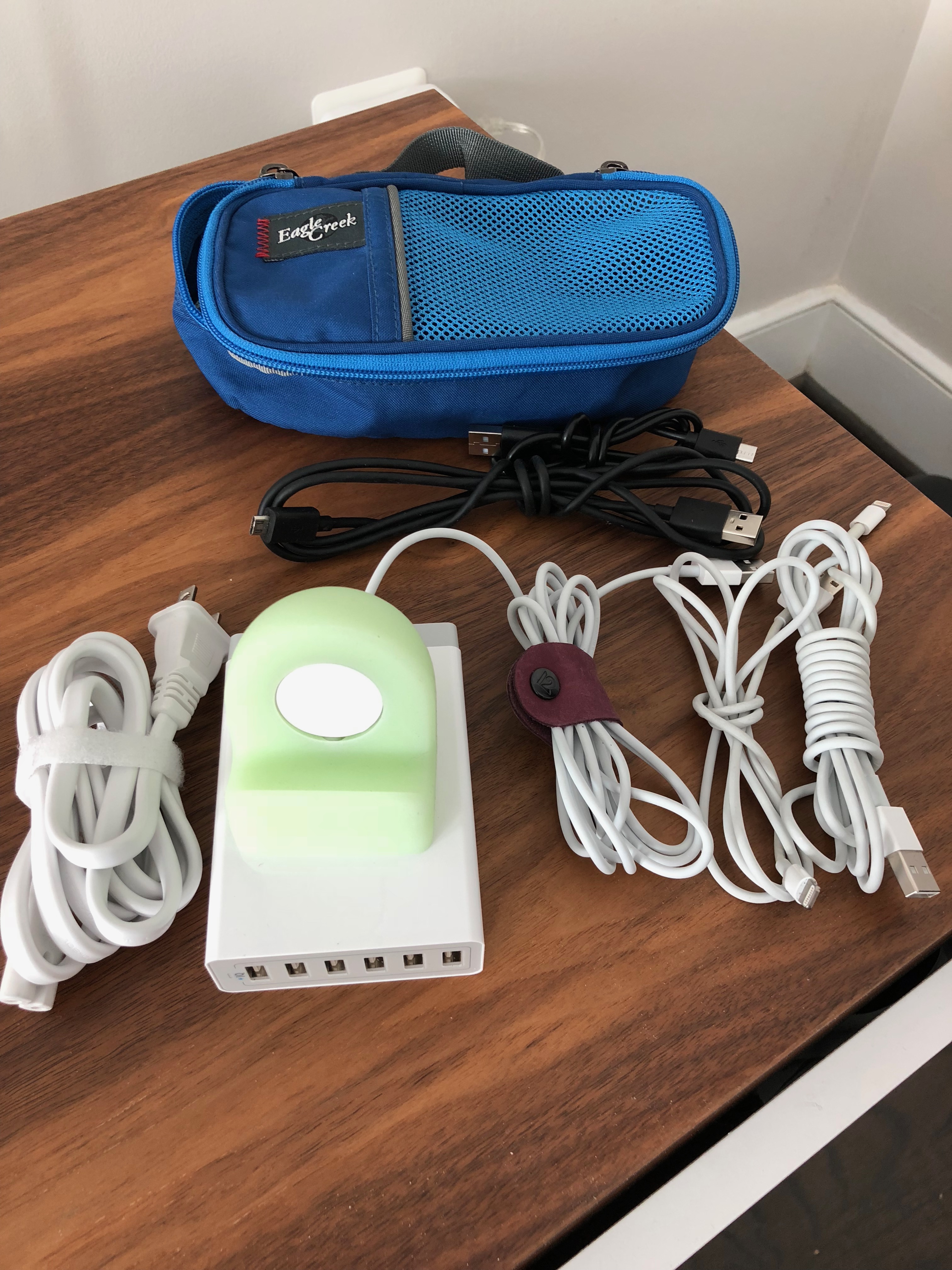
Yes, that is a glow-in-the-dark Apple Watch stand :)
At home, these live together in their cube in my backpack. I don’t use these chargers at all—they are just for travel. This means that whatever happens during packing, as long as at least grab my backpack, I’m can charge my electronics.
The second cube also stays in my backpack and holds the charger for my laptop, inside a Tom Bihn Cubelet (I love Tom Bihn :)
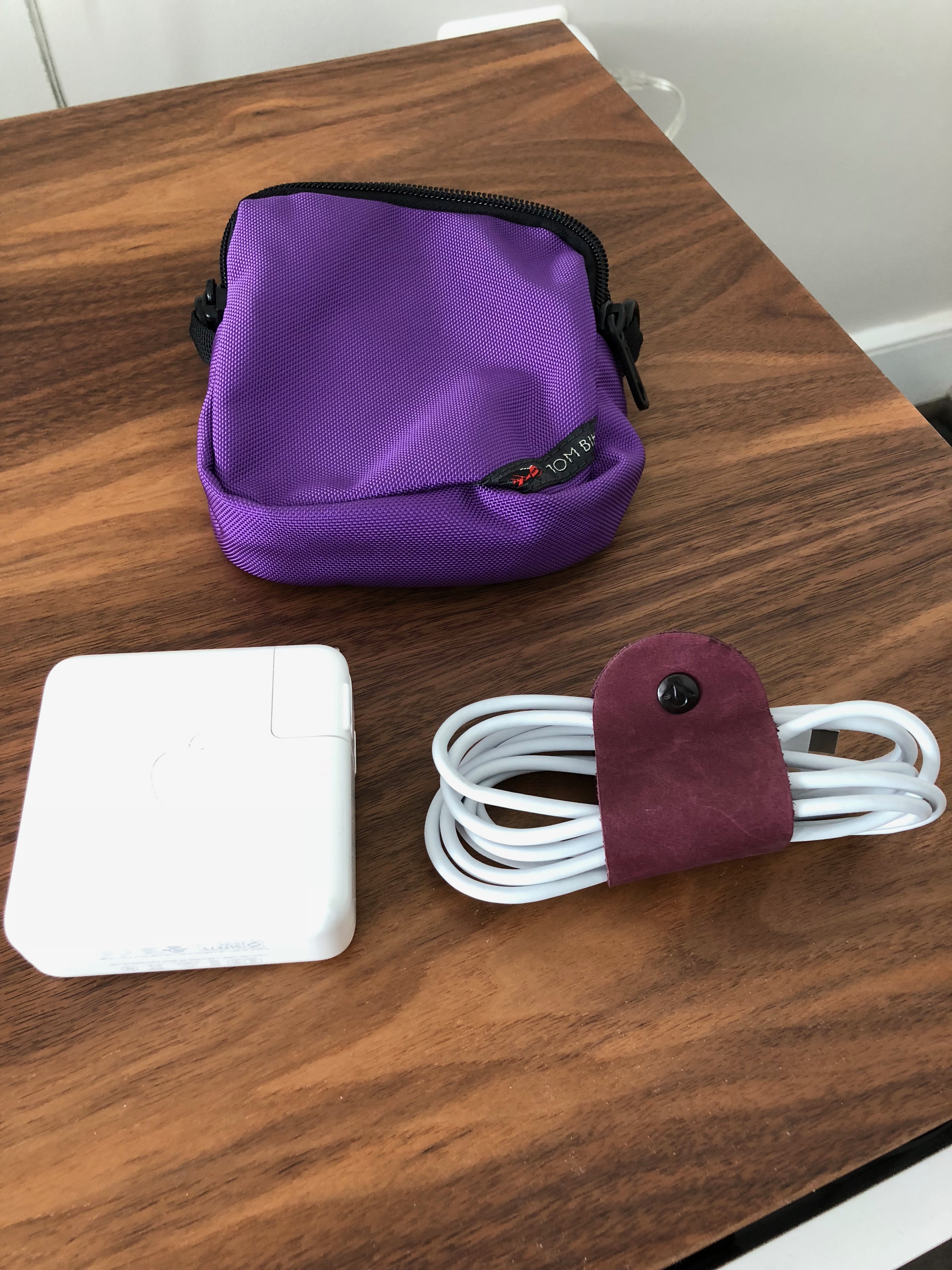
Buying a second power supply is expensive, but again, this mitigates risk, and nothing is more annoying than running out of power for your laptop. Because I have the new MacBook Pro, the USB-C charging is not common, so the chances of borrowing a cable from a co-worker or coffee shop patron are pretty much nil.
The last packing cube is a Tom Bihn Snake Charmer, which fits exactly in the bottom compartment of the Synapse 25. This holds all the other electronic and power gizmos I might need for the trip. In between trips, it tends to be packed up and in my nightstand (it’s too heavy for daily use and I only need this stuff when travelling). It’s mostly insurance against crappy hotel room design, or losing something critical.
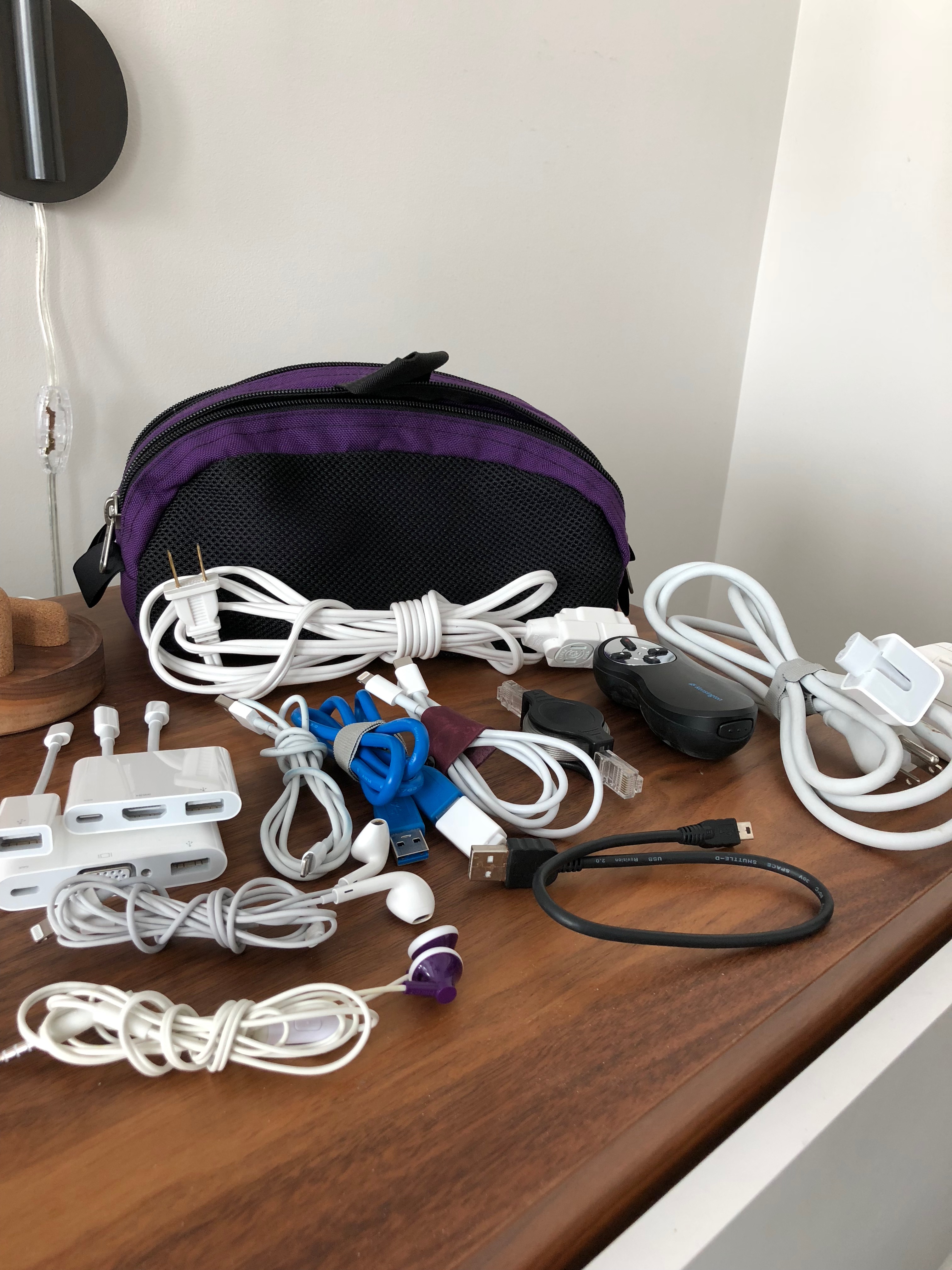
Yes, that is an extension cord and two additional sets of headphones. I like to be prepared :)
It all fits nicely in the Snake Charmer:

Now, it’s time to put all together. You would be amazed at what fits in the Synapse:
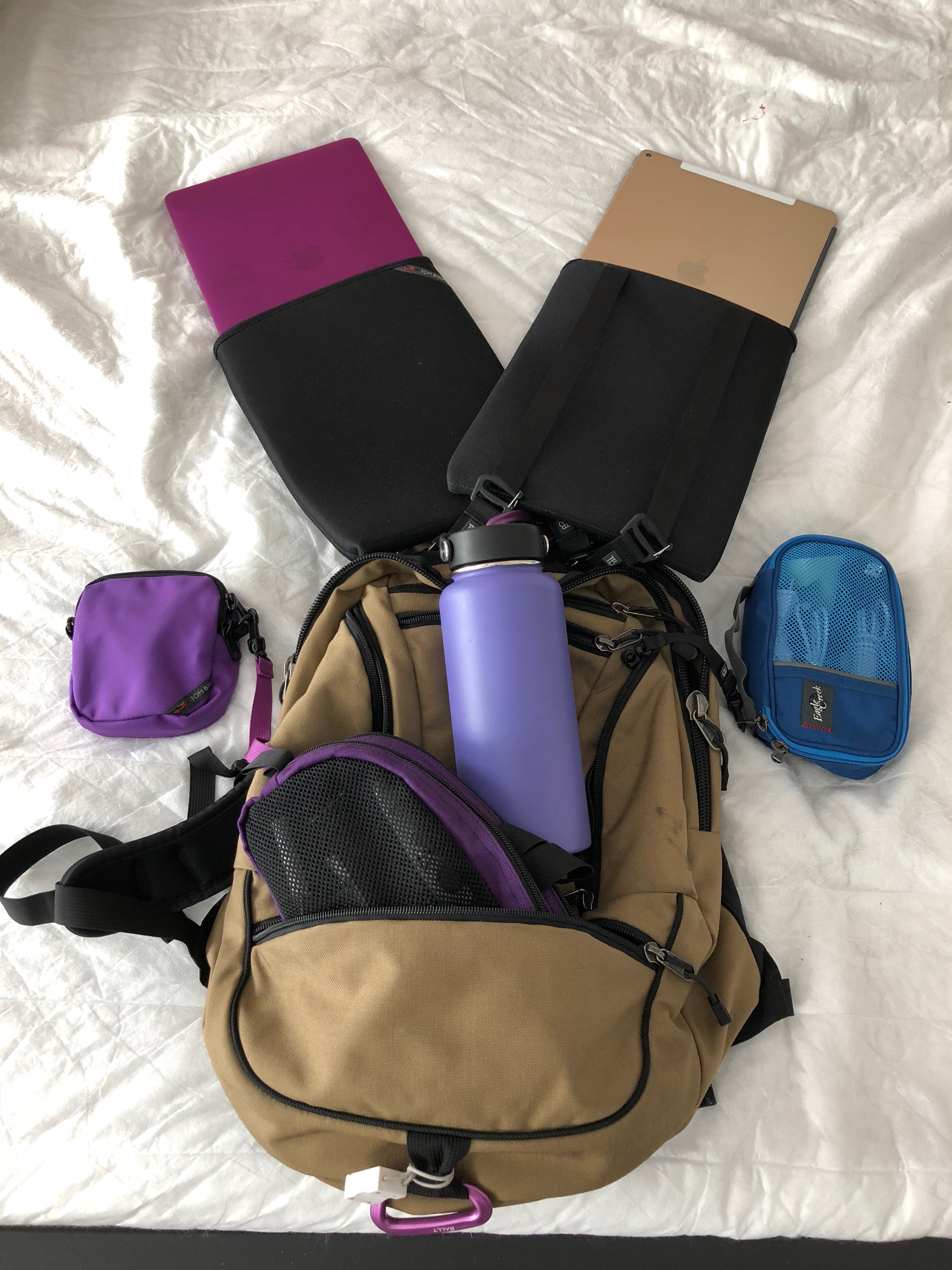
My laptop and iPad go into Tom Bihn Caches, which attach to the inside of the bag and slide out. Also: can you tell my favorite color is purple?
You’ll note the leashes connecting the packing cubes to the bag. The cool thing about these packing cubes is you can pull out an entire bunch of stuff without making a mess, but the leashes prevent them accidentally falling out when you are cramped into a Starbucks surrounded by smelly people yelling about God knows what. Very handy.
Here it is all packed:
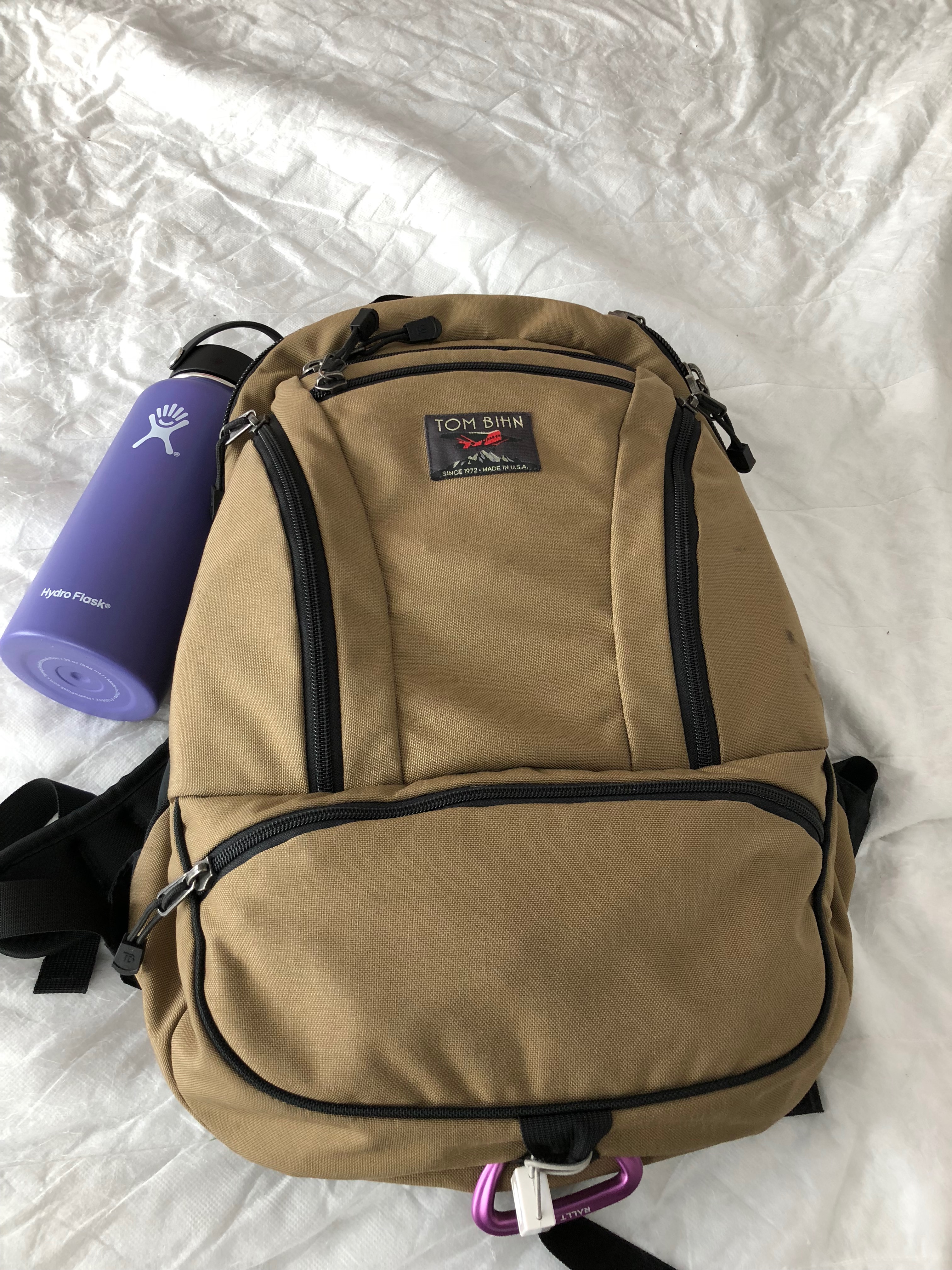
This bag is amazing!
For packing my suitcase, I use some eBags packing cubes as well as two small laundry bags. The laundry bags are quite handy because you can put shoes in them on the way out (since shoes are perpetually dirty), and put your dirty clothes in them during your stay, keeping your hotel room somewhat neat. You can also use them to separate dirty from clean inside your suitcase.
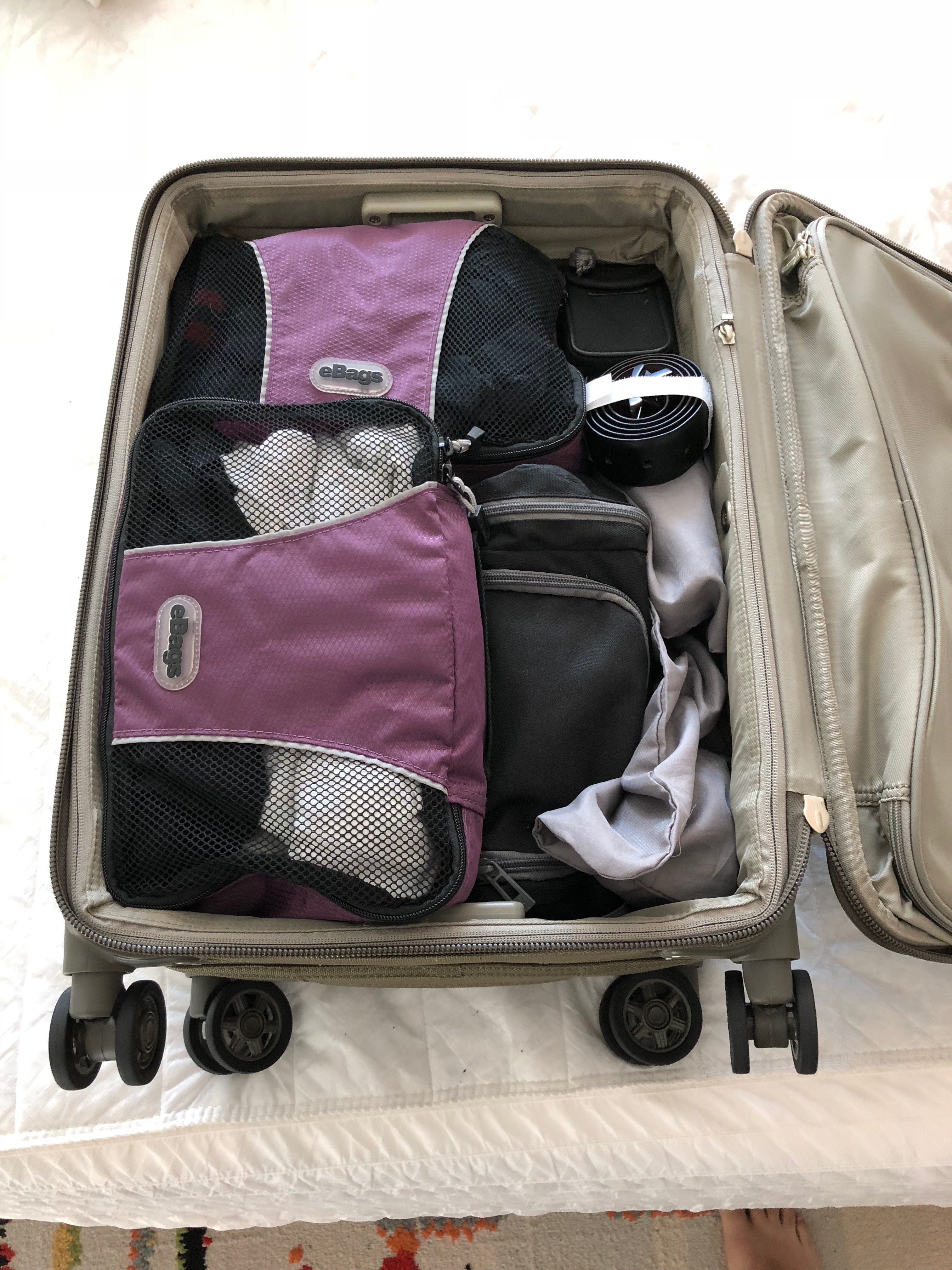
And with that, I’m ready to head to the airport:
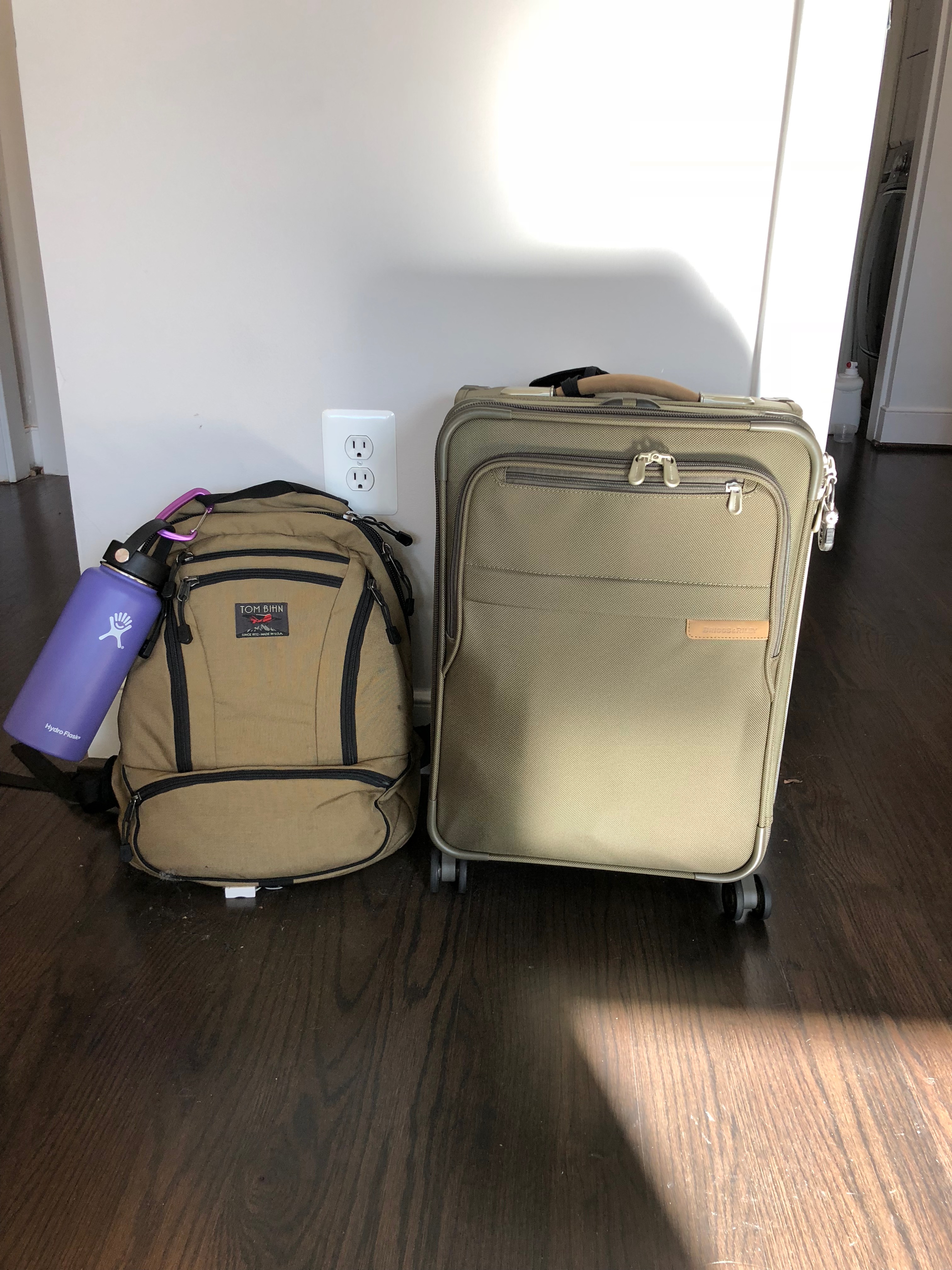
At the Airport
The airport is an unpleasant place, and I have a lot of anxiety about it until I’m safely on board the plane, with my luggage overhead. Working backwards from this means you need to plan your trip from your home to your seat.
There are many obstacles between you and your seat, including several chokepoints where you can get stuck with no way to get out. This means that your timing and planning has to account for this. It also means that any time you aren’t stuck at a chokepoint, you should move expediently to the next place you need to be. Don’t waste time, because it can go away in a flash when a first-time traveller who doesn’t understand how the security line works backs everything up.
Always check-in online before hand, so you can skip the first chokepoint, which is the check-in desk. If you can’t check in online, leave earlier than you normally would. I budget 20 minutes extra for this, because you don’t know what the scene will be like when you get there.
After check-in is the most annoying of all chokepoints: security.
While waiting in line for security, I get myself ready to breeze through the checkpoint. I’ll loosen my laces, remove my belt, and put all my metal/pocket stuff either into my coat pockets (if they can be zipped up—never put stuff into the X-Ray machine that isn’t secured in your bag or clothes), or into the outer pocket on my luggage. This way, all I have to do is put my stuff on the conveyor and pull out my laptop.
It also means, if I’m running late, I can grab my two bags after screening and go on to the next chokepoint instead of fumbling with a big pile of keys, wallets, and cash from a security bin.
After security, you likely have another chokepoint getting to your gate, in the form of a train, tram, or the oft-maligned Dulles Airport Mobile Lounge. Whichever you have to deal with, get on quickly, and stand near the exit. When the doors open, you can be first off and avoid getting stuck behind slowpokes.
Being at the airport is all about time management, and until you are on your plane, you don’t know what sort of chokepoint you’ll find that could eat up 15, 20, or 30 minutes you weren’t planning on. Don’t waste it fumbling around on the train.
You still have two or three more chokepoints to go…this is why I hate airports!
If you have an escalator, be prepared to get stuck. No one in an airport stands to the right so you can pass in a hurry. Everyone blocks the entire thing. You may not need to walk up the escalator, but if you are behind schedule, you can’t afford to just stand there. It may be faster to take the stairs, which no one uses.
Your second-to-last chokepoint is waiting to get on the airplane. The earlier your boarding group is called, the higher your chances of getting your bag in the overhead bin. The gate agents will advise you if your boarding group is likely to require gate-checking, but if you are not in the first coach boarding group (which is often Group 3), you might not be able to get your bag on the plane.
To deal with this, hover around the entrance during boarding so when your group is called, you are the first one in that group. It may feel weird to be That Person, but you aren’t here to make friends. Be polite, courteous, and aware of your surroundings, but prioritize your needs, too.
Depending on your level of anxiety about this, it might be worth paying the “get on first” tax when you book your ticket—most airlines have a relatively inexpensive priority boarding upgrade.
Once you are walking down the ramp, your last chokepoint is getting to your seat. Pay attention to those ahead of you. If overhead bins are filling up, you may need to take one on your way to your seat. If you miss it, going backwards on the plane is difficult, and you could even have to check your bag via the flight attendant.
At this point, the worst is over, and you only need to sit inside a metal tube for 5-6 hours hoping nothing goes wrong.
Once you land, things are easier, because you likely aren’t on a deadline. Head to get a cab or whatever conveyance you are using to get to where you are staying.
Hotels
Knowing how a hotel works makes check-in a snap. They need to know who you are and to authorize your credit card for incidentals, so I have both ready and hand them to the check-in desk on arriving. This speeds things up, but also subtly communicates that you are a seasoned traveller and do not need an extended explanation of how to use your room key.
Do make sure your credit card can handle a large authorization. It’s not uncommon in San Francisco to have over $500 authorized during your stay. Do not use a debit card for this as the authorization will actually take money out of your account.
Always ask for two room keys, especially if they are the magnetic strip kind. You can be sure at least one of these will die during your trip, and if that happens very late at night you don’t want to schlep back down to the reception desk to get a new card. It also means if you lose one, you have a backup.
If you can’t check in immediately, leave your suitcase with the bell desk, but keep your backpack—it’s got all your valuables. Make sure you have a couple bucks for a tip later and, if you don’t, make sure you go somewhere to get change.
Depending on your situation, you could head out for coffee or food, and thanks to the purse hook you can keep your backpack off of the grimy surface that is Everywhere In Downtown San Francisco. I like to stay in the area and check back in, because rooms are often available earlier than the check-in time, and being persistent puts you at the head of the line.
Once I’m in the room, even if I’m super tired or super hungry, I will unpack. Toiletries go into the bathroom, clothes get hung up or put into the dresser, and my nightstand charging station gets assembled. It all only takes a few minutes, but it allows you to double-check you haven’t forgotten something critical. If you have, you’ll find out immediately, and can deal with whatever it is before shops in the area close.
What about AirBnB?
I used AirBnB for many years, but ultimately decided that for work travel, a hotel is the way to go. At a hotel, you have someone waiting to check you in, and your room is very likely to be clean (and if not, you can complain to someone who will fix it immediately). A hotel provides some level of security, and also has facilities like snack machines, a restaurant open late, or ice. AirBnBs tend to have none of that, and if they do, it’s often difficult to know in advance what might actually be available.
In three years of AirBnBs, I have had some very strange and frightening experiences, and overall would not recommend it for business travel. AirBnB isn’t motivated to give you a good or even consistent experience, and so you do not get one. I’ve had to chase down a guy at a donut shop at 8pm to find a key to get into the apartment, buy sheets to replace the dirty ones left on the bed by the previous guests, been asked to lie to the building management if confronted, and been woken up at 3am by someone relentless buzzing the apartment’s doorbell for reasons unknown.
These are not experiences that prepare you to be your best self at work.
That said, shitty Hotel wi-fi is a thing, so be prepared to just suck it up and pay for the extra bandwidth.
During Your Stay
I try to avoid changing timezones internally as it allows me to get up very early and prepare for the day. You do you—whatever rituals you need to stay sane, make time and space to do them.
For me, I like to have ibuprofen handy, plenty of water, and white noise on to cover up the sounds of the city. Just remember that hotels are noisy places and often have terrible window dressings, so if you need silence or darkness to sleep…plan ahead.
Heading Home
Follow the same basic principles as you did packing initially. I do like to separate clean and dirty clothes, if any clothes are clean after the trip. I also pad even more time for getting to the airport because you won’t necessarily know the transportation situation, and, well, I want to get home safe and sound and not miss my flight, so extreme earliness is the way to go.
The other thing for traveling west-to-east coast is that you lose an entire day, so it’s important to have at least one full meal before getting on your plane. Airport food isn’t the best, but if you show up with enough time, you can have a meal without being rushed. Eating at a sit-down restaurant in an airport can be expensive, but they are usually more comfortable and attentive, and I find it can clear my head before getting into that awful airplane seat later.
Random Tidbits
Make sure you have a good credit card that tracks points or miles, especially if you are going to be doing a lot of traveling. Try to use the same airline so you can get status upgrades. After a couple of years traveling to SF on Virgin America, I got status, which means I get to get on first, and have had a few free first-class upgrades over the years. First class is awesome.
One thing that it took me a while to do was to plan travel around what’s truly important. Initially, I planned my travel to minimize my own hassle and anxiety at the expense of time at home with my wife. I later realized that I could shave off a day and half of most trips without it being a problem for work or my travel anxiety. Now, my trips are slighty shorter, which means more time with my wife.
Make sure you are balancing all the tradeoffs when traveling.